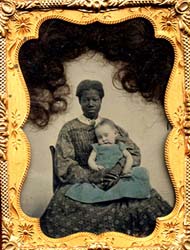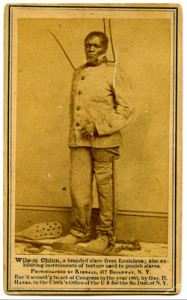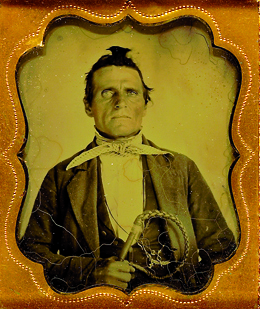New York Times article, “Holding a Mirror to Race,” by Maurice Berger, March 24, 2014:
 |
“The vintage images are as old as the expectations they can summon. An ambrotype from the 1860s with two men of apparently different races, squaring off, fists up. An oddly formal studio portrait of men cloaked in Ku Klux Klan robes. A pensive portrait of an abolitionist. A slave master, clutching a whip and staring defiantly. “But instead of receiving any explanations, viewers have to plumb their own minds — and assumptions — going from each photograph’s poles of black and white into the gray nuances of reality. That is the power behind a remarkable interactive website called ‘Mirror of Race,’ which uses 19th century photographs depicting people of various races in situations that are often ambiguous in their content and intent.” |
Guardian article, “Antique photographs show the history of race in black and white,” by Jonathan Jones, March 28, 2014:
 |
“From a white man in ‘blackface’ to a black Union soldier and an am-dram society dressed as a lynch mob, Mirror of Race’s collection reveals a forgotten world of US race relations." “Early photography is more than a window on history. It is an uncanny and disturbing encounter with real people, the light reflected off their faces falling on chemically sensitized surfaces long ago.“ "The camera has been around now for nearly two centuries. Yet photographs from the 19th century have the same punch as pictures taken digitally today. We are not seeing mere pictures of people, but a trace of the people themselves, as they looked in life.” View a second slide-show article in The Guardian here. |
Art: Das Kunstmagazin article, “Ausstellungen, die ich leader verpassen werde (2): The Mirror of Race,” by Frank Dietz, March 28, 2014:
 |
“Ein Sklaventreiber namens Abraham schaut entschlossen in die Kamera, die Peitsche fest in der rechten Hand. Ein anderes Foto zeigt den völlig vernarbten Rücken des ehemaligen Sklaven Gordon, der von seinem früheren Besitzer misshandelt wurde“ "Die Adams Gallery der Suffolk University in Boston zeigt beeindruckende Fotografien in ihrer aktuellen Ausstellung: The Mirror of Race: Seeing Ourselves through History. Mit Hilfe alter Fotografien aus dem 19. Jahrhundert werden die komplizierten und oft gewaltsamen Beziehungen zwischen den unterschiedlichen Ethnien in den Vereinigten Staaten thematisiert.” |
Boston Globe article, “When photographs are mirrors as well as windows,” by Mark Feeney, December 30, 2013:
 |
“The first words in the Bible are ‘In the beginning.’ The first words in photography are ‘Seeing is believing.’ That statement always raises a question, though. What exactly is being believed? The issue isn’t necessarily the three-dimensional facts that have been captured in two-dimensional form, but the implications — social, political, moral — that those facts have for the viewer. And there’s an important variant of ‘seeing is believing’: Seeing was believing. What was believed about a person or set of social circumstances seen in a photograph 150 years ago may not be believed by viewers of that same photograph today.” |
